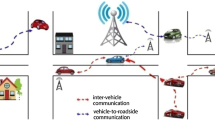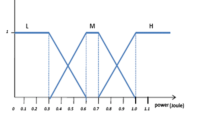Abstract
Worldwide Interoperability for Microwave Access (Wimax) is power station through which mobile network, commonly known as A Mobile Ad-hoc Network (MANET) is used by the people. A MANET can be described as an infrastructure-less and self-configure network with autonomous nodes. Participated nodes in MANETs move through the network constantly causing frequent topology changes. Designing suitable routing protocols to handle the dynamic topology changes in MANETs can enhance the performance of the network. In this regard, this paper proposes four algorithms for the routing problem in MANETs. First, we propose a new method called Classical Logic-based Routing Algorithm for the routing problem in MANETs. Second is a routing algorithm named Fuzzy Logic-based Routing Algorithm (FLRA). Third, a Reinforcement Learning-based Routing Algorithm is proposed to construct optimal paths in MANETs. Finally, a fuzzy logic-based method is accompanied with reinforcement learning to mitigate existing problems in FLRA. This algorithm is called Reinforcement Learning and Fuzzy Logic-based (RLFLRA) Routing Algorithm. Our proposed approaches can be deployed in dynamic environments and take four important fuzzy variables such as available bandwidth, residual energy, mobility speed, and hop-count into consideration. Simulation results depict that learning process has a great impact on network performance and RLFLRA outperforms other proposed algorithms in terms of throughput, route discovery time, packet delivery ratio, network access delay, and hop-count.




















Similar content being viewed by others
References
Clausen, T., & Jacquet, P. (2003). Optimized link state routing protocol (OLSR), RFC 3626, IETF, 2070-1721.
El-Afandi, H. (2006). An intelligent wireless ad hoc routing protocol. Milwaukee: University of Wisconsin at Milwaukee.
Fitzgerald, J., & Dennis, A. (2009). OPNET lab manual. OPNET Technologies.
Garg, N., Aswal, K., & Dobhal, D. C. (2012). A review of routing protocols in mobile ad hoc networks. International Journal of Information Technology, 5(1), 177–180.
Hightower, J., & Borriello, G. (2001). Location systems for ubiquitous computing. Computer, 34(8), 57–66.
Johnson, D., Hu, Y.-c., & Maltz, D. (2007). The dynamic source routing protocol (DSR) for mobile ad hoc networks for IPv4, RFC 4728, 2070-1721.
Kumar Jain, Y., & Kumar Verma, R. (2012). Energy level accuracy and life time increased in mobile ad-hoc networks using OLSR. International Journal of Advanced Research in Computer Science and Software Engineering, 2, 97–103.
Kumar, K., & Singh, V. (2014). Power consumption based simulation model for mobile ad-hoc network. Wireless Personal Communications, 77(2), 1437–1448.
Mauve, M., Widmer, J., & Hartenstein, H. (2001). A survey on position-based routing in mobile ad hoc networks. IEEE Network, 15(6), 30–39.
Moussaoui, A., Semchedine, F., & Boukerram, A. (2014). A link-state QoS routing protocol based on link stability for Mobile Ad hoc Networks. Journal of Network and Computer Applications, 39, 117–125.
Naruephiphat, W., & Usaha, W. (2008). Balanced energy-efficient routing in MANETs using reinforcement learning. Paper presented at the international conference on information networking, 2008. ICOIN 2008.
Negnevitsky, M. (2005). Artificial intelligence: A guide to intelligent systems. Upper Saddle River: Pearson Education.
Park, V., & Corson, M. S. (1997). Temporally-ordered routing algorithm (TORA) functional specification. Internet Draft, July 2001. Available from: http://tools.ietf.org/id/draft-ietf-manet-tora-spec-04.txt.
Park, V. D., & Corson, M. S. (1997). A highly adaptive distributed routing algorithm for mobile wireless networks. Paper presented at the INFOCOM’97. Sixteenth annual joint conference of the IEEE computer and communications societies. Driving the information revolution, proceedings of IEEE.
Perkins, C., Belding-Royer, E., & Das, S. (2003). Ad hoc on-demand distance vector (AODV) routing, RFC 3561, IETF, 2070-1721.
Raich, A., & Vidhate, A. (2013). Best path finding using location aware AODV for MANET. International Journal of Advanced Computer Research, 3(3), 336.
Santhi, G., Nachiappan, A., Ibrahime, M. Z., Raghunadhane, R., & Favas, M. (2011). Q-learning based adaptive QoS routing protocol for MANETs. In 2011 international conference on recent trends in information technology (ICRTIT) (pp. 1233–1238). IEEE.
Sivakumar, B., Bhalaji, N., & Sivakumar, D. (2014). A survey on investigating the need for intelligent power-aware load balanced routing protocols for handling critical links in MANETs. The Scientific World Journal.
Tabatabaei, S., & Hosseini, F. (2016). A fuzzy logic-based fault tolerance new routing protocol in mobile ad hoc networks. International Journal of Fuzzy Systems, 18, 883–893.
Tabatabaei, S., Teshnehlab, M., & Mirabedini, S. J. (2015). A new routing protocol to increase throughput in mobile ad hoc networks. Wireless Personal Communications, 83(3), 1765–1778.
Vu, T. K., & Kwon, S. (2014). Mobility-assisted on-demand routing algorithm for MANETs in the presence of location errors. The Scientific World Journal, 2014. doi:10.1155/2014/790103.
Welch, G., & Bishop, G. (1995). An introduction to the Kalman filter. Technical Report TR 95-041. University of North Carolina at Chapel Hill, Chapel Hill, NC, USA.
Xia, H., Jia, Z., Li, X., Ju, L., & Sha, E. H.-M. (2013). Trust prediction and trust-based source routing in mobile ad hoc networks. Ad Hoc Networks, 11(7), 2096–2114.
You, L., Li, J., Wei, C., Dai, C., Xu, J., & Hu, L. (2014). A hop count based heuristic routing protocol for mobile delay tolerant networks. The Scientific World Journal, 2014. doi:10.1155/2014/603547.
Zadeh, L. A. (1996). Fuzzy logic= computing with words. IEEE Transactions on Fuzzy Systems, 4(2), 103–111.
Author information
Authors and Affiliations
Corresponding author
Rights and permissions
About this article
Cite this article
Tabatabaei, S., Behravesh, R. New Approaches to Routing in Mobile Ad hoc Networks. Wireless Pers Commun 97, 2167–2190 (2017). https://doi.org/10.1007/s11277-017-4602-8
Published:
Issue Date:
DOI: https://doi.org/10.1007/s11277-017-4602-8




